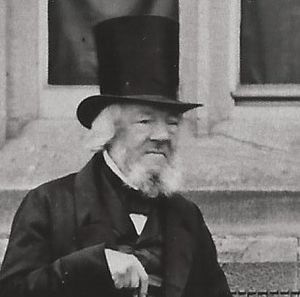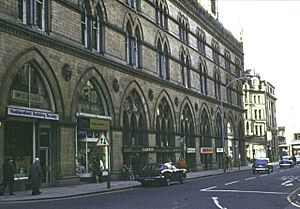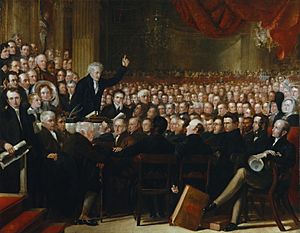Benjamin Godwin facts for kids
Quick facts for kids
Benjamin Godwin
|
|
|---|---|

from a photograph by his son
|
|
| Born | 10 October 1785 |
| Died | 20 February 1871 |
| Nationality | British |
| Spouse(s) | Elizabeth |
Benjamin Godwin (born 1785, died 1871) was a special kind of church leader called a Baptist minister. He was also a strong supporter of ending slavery. He worked as a minister in places like Dartmouth, Bradford, and Oxford. He also taught important subjects like classics.
Benjamin Godwin was very involved in discussions about whether slavery was right or wrong. He also helped solve a big disagreement within the Baptist church's missionary group. We know a lot about his life because he wrote 58 letters to his son. These letters told his life story. His son and grandson later became important leaders (Mayors) in the city of Bradford.
Contents
Early Life and Adventures
Benjamin Godwin was born in Bath in 1785. His father was much older, and Benjamin was given his name because his father was a strong Baptist. His family was not rich. He went to a free school called the Bluecoat School. After school, he started learning to be a shoemaker.
A Sailor's Journey
Benjamin was unhappy as a shoemaker. When he was fifteen, he ran away with a friend. They joined a ship sailing to the Mediterranean Sea. During this trip, Benjamin felt closer to his faith. He left the ship in Palermo and found work as a cabin boy on another ship.
However, in Menorca, on his 16th birthday, Benjamin and his whole crew were forced to join the Royal Navy. This was called being "press-ganged." He became a sailor during the Napoleonic Wars. When peace was declared in 1802, he left the navy.
Finding His Path
After leaving the navy, Benjamin became very interested in religion again. He went to his family's Baptist Church. He also lived with his older half-sister and her husband. He tried building houses, but he was better at making shoes.
Benjamin confirmed his faith by being baptized with five other adults. At church, he met Elizabeth Hall, who he called "Betsy." She would not marry him until he could support her. Betsy was not impressed when Benjamin first gave a sermon (a church talk). But after he gave three good sermons in Bath, she changed her mind.
Others were also impressed. Benjamin was offered a part-time job as a church speaker in Aylburton. Betsy agreed to marry him, and they got married on August 14, 1806. They moved into a cottage and started church meetings there. Benjamin felt very inspired by his wife.
However, they were very poor and faced strong opposition. People even threw eggs at them! Benjamin heard he had been tricked into joining the army again, so he left Aylburton in 1807.
Becoming a Minister
Benjamin was now sure he wanted to be a minister. He spent a year helping a church in Chacewater, Cornwall. He was guided by another minister nearby. Betsy stayed in Bath because there wasn't much money. Benjamin helped at a local school and continued his own studies. After a year, he decided to leave and join his wife to become a full-time minister.
Benjamin and Betsy spent a year in Chipping Sodbury. He humbly turned down an offer to be their pastor. Instead, he took a job in Dartmouth. Here, he could preach, learn, and teach. He officially became a minister for Dartmouth in 1812.
In Dartmouth, Benjamin's daughter, Mary, sadly died from whooping cough. But they also had a son, John, in 1814. Benjamin was ready to move again. He became a minister in Great Missenden. He worked well with the local Anglican church leader, raising money for missionary work. However, he was disappointed that his own church was losing members.
A Teacher and Leader in Bradford
In 1822, Benjamin Godwin moved to Bradford. He became a teacher of classics at the Horton Academy. This academy trained Baptist ministers. Benjamin had first said no to the job. But the academy's leader, William Steadman, kept asking because he was impressed by Benjamin's first published sermon.
Benjamin worried his own education wasn't good enough to teach adults. But he was wrong! He eagerly started new classes in math, physics, and geography. At this time, he was not preaching.
Minister and Anti-Slavery Champion
In 1824, a new church called Sion Chapel was built in Bradford. Benjamin became its minister on October 31, 1824. He was very happy to have more freedom in this new role.
By 1830, Benjamin Godwin had achieved his goal. He and his wife decided their next big challenge was to fight against slavery. He talked to a leading anti-slavery activist, James Stephen. Then, Benjamin gave a series of popular talks at the new Bradford Exchange buildings. People paid to attend these talks.
These were not just simple lectures. Benjamin used special slides and hired an artist named Thomas Richmond. The artist created large paintings to show the terrible effects of slavery. Benjamin believed that if people saw the truth, they would want to end slavery. He also had the artist prepare a second series of paintings. These showed the good things that would happen if slavery was abolished and everyone was treated equally.
Benjamin's talks were perfect for the new Bradford Mechanics' Institute Library. This building, which opened in 1832, was designed to help adults learn. Benjamin encouraged its creation. His anti-slavery talks gained wider attention. A man named Zachary Macaulay, who edited an anti-slavery newspaper, asked Benjamin to give talks across the country. This was too big a task. But Benjamin did give his four illustrated lectures in York and Scarborough. His talks were written about in local newspapers and published as a 170-page book in London and America.
Benjamin also helped gather a large petition in Yorkshire. This was to encourage the British anti-slavery movement to do more. He also actively helped Henry Brougham, who was running for parliament and wanted to end slavery. Benjamin created and paid for posters to encourage voters in Yorkshire to support Brougham. He reminded them that they had supported the famous abolitionist William Wilberforce before.
Benjamin's book of lectures quickly sold out. Copies were sent to important people in parliament. Anti-slavery speakers used his book as a key resource. Important international activists like George Thompson and John Scoble read it.
By 1833, parliament was more democratic. Anti-slavery activists wanted to make sure their elected leaders voted to outlaw slavery. More petitions were organized in Bradford. Benjamin was one of the people sent to London to a meeting. This meeting planned how to convince parliament.
The Slavery Abolition Act 1833 was passed, making slavery illegal across the British Empire! On April 24, 1834, Benjamin Godwin was honored for his leadership in the anti-slavery fight. He received thanks and gifts like tea sets and silver. Members of parliament attended the celebration.
Newspaper and Challenges
In 1834, a new newspaper, the Bradford Observer, was started. Benjamin Godwin was one of the people who led this idea. He suggested the newspaper should appeal to everyone, not just one political group. It should try to show what was good for both bosses and workers. The newspaper was a success. Benjamin also organized groups to support parliamentary reform and fight against slavery.
In 1836, Benjamin felt he wasn't getting the support he deserved and resigned from his position. People campaigned to keep him in Bradford, and he agreed to stay. But a few months later, he still felt unsupported. He had even given up his teaching role at Horton Academy to focus on his church work. Despite having nowhere else to go, he resigned again and stuck to his decision.
A Peacemaker and Minister in Oxford
Benjamin Godwin was looking for a new role. He became involved in a disagreement between the Baptist Missionary Society and missionaries in India. Benjamin and his wife moved to Liverpool. He was paid to be a secretary for a committee set up to solve the problem.
The disagreement had lasted ten years. It happened because the mission in India had been set up with some independence. After a long-serving leader died, the main society wanted to make sure everything was properly owned and documented. The older missionaries in India owned some buildings that they held for the mission. Some people thought this could look like personal profit, even though no one directly accused them. The missionaries felt that being asked to transfer ownership was an insult to their character.
Benjamin's job was to travel around Britain, explaining the misunderstandings. He also tried to arrange a visit to the missionaries in India. Benjamin went beyond his job description. In November 1836, he organized a difficult two-day meeting. This meeting led to the two groups merging. With no more disagreement, Benjamin no longer had a job. He felt very successful, but he was out of work again.
Life in Oxford
In 1838, Benjamin became the Baptist minister at New Street Church in Oxford. In March of that year, he started writing the first of 58 letters about his life. He continued writing these until December 1855.
During the 1840 World Anti-Slavery Convention, he wrote a paper about whether slavery was right or wrong. Everyone at the convention agreed with his paper. It said that not only slavery was wrong, but also religious leaders who had failed to speak out against it. The convention decided to write to every religious leader to share this view. They also asked religious groups to remove any supporters of slavery from their communities.
Benjamin Godwin is included in a large painting that remembers the 1840 convention. You can just see him behind the head of Joseph Sturge, who organized the meeting. The painting is now in the National Portrait Gallery. Benjamin met many international anti-slavery activists. He was even invited to meet French abolitionists in Paris the next year.
In 1845, Benjamin resigned from his job in Oxford because his health was failing. The next year, he and his wife returned to Bradford. They lived in a house that his son had arranged for them. In 1847, his son got married. Benjamin continued to work for the Baptist Missionary Society. He also lectured at Horton College again in 1850.
One of his later achievements was becoming President of Bradford's Ragged School in 1854. This school helped poor children and opened with seven students. Another honor was becoming president of a new female Anti-Slavery Society in Bradford in 1856. His wife was the secretary, and there were 24 women on the committee.
On December 23, 1855, Benjamin gave his son the 58 letters about his life. He had promised to write these letters almost twenty years before. These letters are now studied by experts and are a great source of information about Benjamin's life and the important events he was part of.
Benjamin Godwin died in 1871.
Selected Publications
- The Substance of a Course of Lectures on British Colonial Slavery: Delivered at Bradford, York and Scarborough, 1830
- Paper presented to the General Anti-Slavery Convention, 1840
- The Philosophy of Atheism Examined and Compared with Christianity. A course of popular lectures delivered at the Mechanics’ Institute, Bradford, on Sunday afternoons, in the winter of 1852-1853, 1853




